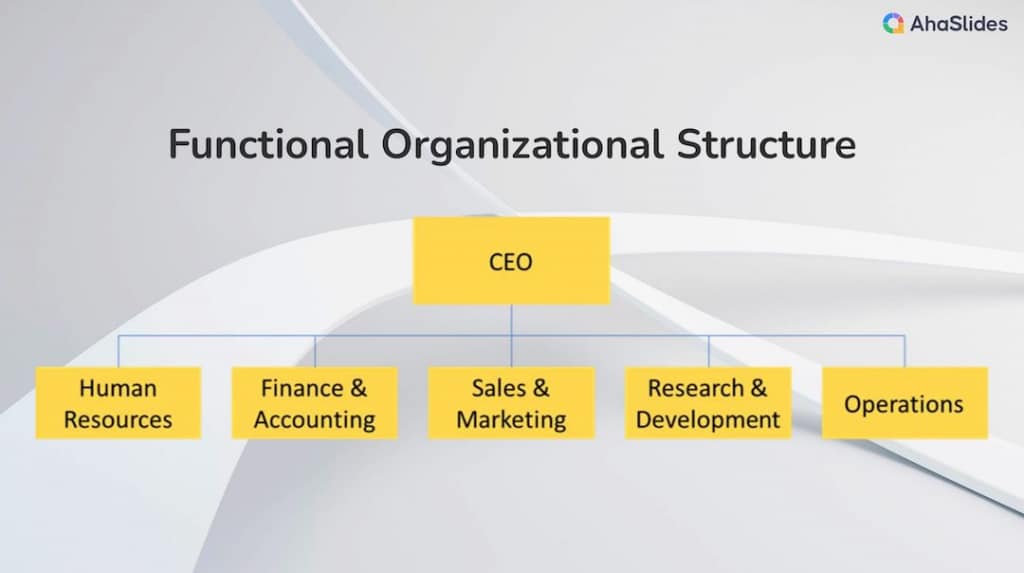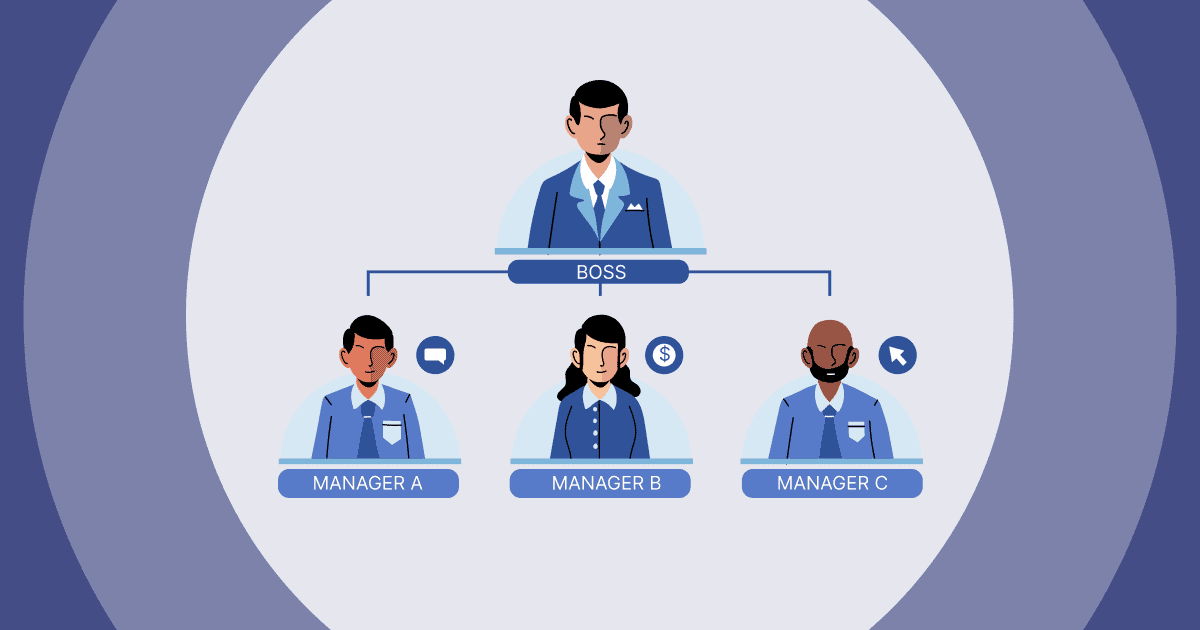क्या आपने कभी सोचा है कि बड़ी कंपनियाँ सभी गतिशील भागों के बीच स्वयं को कैसे व्यवस्थित करती हैं?
जबकि कुछ व्यवसाय एक एकजुट इकाई के रूप में कार्य करते हैं, कई कार्य के आधार पर अलग-अलग विभाग स्थापित करते हैं। इसे ए के नाम से जाना जाता है कार्यात्मक संगठनात्मक संरचना.
चाहे वह विपणन, वित्त, संचालन, या आईटी हो, कार्यात्मक संरचनाएं विशेषज्ञता के अनुसार टीमों का विभाजन करती हैं।
सतह पर, कर्तव्यों का यह पृथक्करण स्पष्ट प्रतीत होता है - लेकिन वास्तव में इसका सहयोग, निर्णय लेने और समग्र व्यवसाय पर क्या प्रभाव पड़ता है?
इस पोस्ट में, हम कार्यात्मक मॉडल और उसके लाभों पर एक नज़र डालेंगे। सीधे अंदर गोता लगाएँ!
| कार्यात्मक संगठन के उदाहरण क्या हैं? | स्केलेबल, स्टारबक्स, अमेज़ॅन। |
| कार्यात्मक संगठनात्मक संरचना के लिए किस प्रकार का संगठन उपयुक्त है? | बड़ी कंपनियां। |
टेबल ऑफ़ कंटेंट
- एक कार्यात्मक संगठनात्मक संरचना क्या है?
- कार्यात्मक संगठनात्मक संरचना के लाभ
- कार्यात्मक संगठनात्मक संरचना के नुकसान
- कार्यात्मक संगठनात्मक संरचना की चुनौतियों पर काबू पाना
- एक कार्यात्मक संरचना कब उपयुक्त होती है?
- कार्यात्मक संगठनात्मक संरचना के उदाहरण
- चाबी छीन लेना
- अक्सर पूछे जाने वाले प्रश्न
AhaSlides के साथ अधिक सुझाव

सभाओं के दौरान अधिक मज़ा खोज रहे हैं?
AhaSlides पर एक मजेदार क्विज़ के ज़रिए अपने टीम के सदस्यों को इकट्ठा करें। AhaSlides टेम्पलेट लाइब्रेरी से मुफ़्त क्विज़ लेने के लिए साइन अप करें!
🚀 फ्री क्विज ☁️ लें
एक कार्यात्मक संगठनात्मक संरचना क्या है?

कई कंपनियाँ लोगों द्वारा की जाने वाली नौकरियों या कार्यों के प्रकार के आधार पर खुद को अलग-अलग विभागों में व्यवस्थित करना चुनती हैं, और काम को अधिक विशिष्ट नौकरियों में विभाजित करती हैं।
इसे कहते हैं "कार्यात्मक संगठनात्मक संरचना"एक ही परियोजना पर काम करने वाले सभी लोगों को एक साथ समूहीकृत करने के बजाय, लोगों को उनके कार्य के सामान्य क्षेत्र के आधार पर समूहीकृत किया जाता है - जैसे विपणन, वित्त, संचालन, ग्राहक सेवा, इत्यादि।
उदाहरण के लिए, हर कोई जो विज्ञापन बनाता है, सोशल मीडिया अभियान चलाता है, या नए उत्पाद विचारों के बारे में सोचता है, वह विपणन विभाग में होगा। सभी अकाउंटेंट जो पैसे पर नज़र रखते हैं, बिलों का भुगतान करते हैं और कर दाखिल करते हैं, वित्त में एक साथ होंगे। संचालन में इंजीनियर अन्य इंजीनियरों के साथ मिलकर काम करेंगे।
विचार यह है कि समान कार्य कौशल वाले सभी लोगों को एक साथ रखकर, वे एक-दूसरे की मदद कर सकते हैं और एक-दूसरे की विशेषज्ञता से सीख सकते हैं। वित्तीय प्रक्रियाओं जैसी चीज़ों को भी पूरे विभाग में मानकीकृत किया जा सकता है।
यह संरचना इसे बहुत कुशल बनाती है क्योंकि विशेषज्ञों को लगातार अपने विभाग के बाहर उत्तरों की तलाश नहीं करनी पड़ती। लेकिन यह विभिन्न क्षेत्रों के लिए बड़ी परियोजनाओं पर अच्छी तरह से सहयोग करना भी कठिन बना सकता है, जिसके लिए कई कौशल की आवश्यकता होती है। कभी-कभी विभागों के बीच संचार भी खो सकता है।
कुल मिलाकर, कार्यात्मक संरचनाएँ स्थापित कंपनियों के लिए अच्छी होती हैं जहाँ प्रक्रियाएँ निर्धारित होती हैं, लेकिन कंपनियों को अपने स्वयं के काम करने से बचने के लिए अंतर-विभागीय स्तर पर भी लोगों को एक साथ लाने के तरीके खोजने की ज़रूरत होती है। साइलो बहुत ज्यादा।
कार्यात्मक संगठनात्मक संरचना के लाभ

कार्यात्मक संगठनात्मक संरचना के प्रमुख लाभों का पता नीचे दिया गया है:
- श्रम का विशिष्टीकरण - लोग केवल उन्हीं कार्यों पर ध्यान केंद्रित करके अपने विशिष्ट कार्य में विशेषज्ञता हासिल करते हैं। इससे उत्पादकता बढ़ती है।
- विशेषज्ञता का केंद्रीकरण - प्रत्येक विभाग में समान विशेषज्ञता को एक साथ रखा जाता है। कर्मचारी एक दूसरे से सीख सकते हैं और एक दूसरे का समर्थन कर सकते हैं।
- प्रथाओं का मानकीकरण - स्थिरता के लिए प्रत्येक कार्य के भीतर काम करने के सामान्य तरीकों को विकसित और प्रलेखित किया जा सकता है।
- रिपोर्टिंग की स्पष्ट रेखाएँ - यह स्पष्ट है कि कर्मचारी अपनी भूमिका के आधार पर किसे रिपोर्ट करते हैं, बिना कई प्रबंधकों को मैट्रिक्स रिपोर्टिंग के। इससे निर्णय लेने में आसानी होती है।
- संसाधनों का लचीला आवंटन - बदलती प्राथमिकताओं और कार्यभार के आधार पर विभागों के भीतर श्रम और पूंजी को अधिक आसानी से स्थानांतरित किया जा सकता है।
- पैमाने की अर्थव्यवस्था - उपकरण और कर्मचारियों जैसे संसाधनों को प्रत्येक विभाग के भीतर साझा किया जा सकता है, जिससे उत्पादन की प्रति इकाई लागत कम हो जाती है।
- कार्य निष्पादन की निगरानी में आसानी - चूंकि कार्य अलग-अलग होते हैं, इसलिए विभागीय मीट्रिक्स को लक्ष्यों और परिणामों से अधिक स्पष्ट रूप से जोड़ा जा सकता है।
- कैरियर विकास के अवसर - कर्मचारी अपने विशेष क्षेत्र में भूमिकाओं के बीच स्थानांतरित होकर अपने कौशल और करियर को आगे बढ़ा सकते हैं।
- प्रबंधन सरलीकरण - प्रत्येक विभाग प्रमुख के पास एक एकल समरूप इकाई पर अधिकार होता है, जिससे प्रबंधन कम जटिल हो जाता है।
तो संक्षेप में, एक कार्यात्मक संरचना व्यक्तिगत कार्यों के भीतर विशेषज्ञता, विशेषज्ञता का लाभ उठाने और परिचालन दक्षता को बढ़ावा देती है।
कार्यात्मक संगठनात्मक संरचना के नुकसान

सिक्के के दूसरी तरफ, एक कार्यात्मक संगठनात्मक संरचना पूरी तरह से दोषरहित नहीं है। कंपनियों को इन संभावित असफलताओं पर विचार करना चाहिए:
- साइलो मानसिकता - विभाग समग्र संगठन के लक्ष्यों के बजाय केवल अपने लक्ष्यों पर ध्यान केंद्रित कर सकते हैं। इससे सहयोग में बाधा आती है।
- प्रयासों का दोहराव - एक ही कार्य को विभिन्न विभागों में बार-बार किया जा सकता है, न कि विभिन्न कार्यों में सुव्यवस्थित किया जा सकता है।
- निर्णय लेने में देरी - विभागों से संबंधित मुद्दों को सुलझाने में अधिक समय लगता है, क्योंकि उन्हें विभागों के बीच समन्वय की आवश्यकता होती है।
- खराब ग्राहक सेवा - कई विभागों के साथ बातचीत करने वाले ग्राहकों को असंगत या खंडित अनुभव प्राप्त हो सकता है।
- जटिल प्रक्रियाएं - ऐसे कार्य जिनमें अंतर-कार्यात्मक सहयोग की आवश्यकता होती है, वे पेचीदा, अकुशल और निराशाजनक हो सकते हैं।
- परिवर्तन के प्रति लचीलापन - जब बाजार की आवश्यकताएं बदलती हैं या नए अवसर उत्पन्न होते हैं तो संसाधनों को शीघ्रता से स्थानांतरित करना और संरेखित करना कठिन होता है।
- ट्रेड-ऑफ का मूल्यांकन करने में कठिनाई - कार्यात्मक निर्णयों के व्यापक प्रभावों को अंतर-निर्भरता पर विचार किए बिना नजरअंदाज किया जा सकता है।
- पर्यवेक्षकों पर अत्यधिक निर्भरता - कर्मचारी व्यापक दृष्टिकोण विकसित करने के बजाय अपने विभाग के नेता पर बहुत अधिक निर्भर रहते हैं।
- नवप्रवर्तन में रुकावट - विभिन्न क्षेत्रों से इनपुट की आवश्यकता वाले नए विचारों को समर्थन प्राप्त करने में कठिनाई होती है।
कार्यात्मक साइलो, धीमी गति से निर्णय लेने और सहयोग की कमी इस संरचना वाले संगठन की दक्षता और लचीलेपन को कमजोर कर सकती है।
कार्यात्मक संगठनात्मक संरचना की चुनौतियों पर काबू पाना
मार्केटिंग, बिक्री और सहायता जैसे विभिन्न कार्य समूहों के लिए आपस में जुड़ना मुश्किल हो सकता है, अगर वे हमेशा अपने-अपने कोनों में ही रहते हैं। लेकिन अलग-थलग रहने से वास्तव में काम पूरा करना मुश्किल हो जाता है। चुनौतियों से निपटने के लिए यहाँ कुछ उपाय दिए गए हैं:
विभिन्न क्षेत्रों के लोगों के साथ प्रोजेक्ट बनाएं। यह सभी का परिचय कराता है और उन्हें एक-दूसरे की मदद करने के लिए प्रेरित करता है।
इकाइयों को बंधन में मदद करने के लिए लोगों को चुनें। उत्पाद/ग्राहक प्रबंधकों को नियुक्त करें, वे सुनिश्चित करेंगे कि सभी लोग अपडेट साझा करें और मुद्दों को एक साथ हल करें।
साझा लक्ष्यों पर ध्यान केंद्रित करें, प्रत्येक क्षेत्र को अपना काम करने के बजाय, बड़ी कंपनी के सपनों के आसपास संरेखित करें जिनका वे सभी समर्थन करते हैं।
एचआर या आईटी जैसी डुप्लिकेट भूमिकाओं को समेकित करें ताकि एक टीम सभी बनाम विभाजन कार्य को पूरा कर सके।
ऐसी बैठकें तय करें, जहां क्षेत्र एक-दूसरे को संक्षेप में बताएं कि क्या हो रहा है। समस्याओं को शुरू में ही खत्म करें।

सहयोगात्मक उपकरणों में निवेश करें - इंट्रानेट, दस्तावेज़/फ़ाइल साझाकरण या परियोजना प्रबंधन ऐप जैसी प्रौद्योगिकियां समन्वय को सुगम बना सकती हैं।
लचीले घुमावों को बढ़ावा दें। एक-दूसरे को बेहतर ढंग से समझने और एक अलग दृष्टिकोण विकसित करने के लिए कर्मचारियों को अस्थायी रूप से अन्यत्र अन्य भूमिकाएँ आज़माने दें।
टीमवर्क पर भी नज़र रखें। लोगों के बीच आपसी तालमेल और टीम के समग्र KPI पर ध्यान दें, न कि केवल व्यक्तिगत उपलब्धियों पर। नेताओं को संगठनात्मक तालमेल पर ध्यान केंद्रित करने के लिए प्रोत्साहन दें, न कि केवल कार्यात्मक KPI पर।
अंत में, सामाजिक संपर्क को प्रोत्साहित करें ताकि प्रत्येक विभाग मदद के लिए एक-दूसरे से संपर्क करने में अधिक सहज हो जाए। कार्यों के परस्पर क्रिया करने और एक दूसरे पर निर्भर संपूर्ण के रूप में काम करने के तरीके खोजने से साइलो को तोड़ने में मदद मिलेगी।
AhaSlides के साथ बर्फ तोड़ें
प्रत्येक विभाग को AhaSlides की अन्तरक्रियाशीलता से जुड़ने और जुड़ने में मदद करें। कंपनियों के बॉन्डिंग सत्रों के लिए आवश्यक!🤝

एक कार्यात्मक संरचना कब उपयुक्त होती है?

यह देखने के लिए सूची जांचें कि क्या आपका संगठन इस संरचना को बनाने के लिए उपयुक्त है:
☐ मानकीकृत परिचालन वाली स्थापित कंपनियां - परिपक्व कंपनियों के लिए जिनकी मुख्य प्रक्रियाएं और कार्यप्रवाह अच्छी तरह से परिभाषित हैं, कार्यों के भीतर विशेषज्ञता दक्षता को बढ़ावा दे सकती है।
☐ स्थिर कारोबारी माहौल - यदि बाजार और ग्राहकों की जरूरतें अपेक्षाकृत पूर्वानुमानित हैं, तो कार्यात्मक समूह तेजी से विभाग-पार सहयोग की आवश्यकता के बिना अपने विशेषज्ञ क्षेत्रों को अनुकूलित करने पर ध्यान केंद्रित कर सकते हैं।
☐ समर्पित विशेषज्ञता की आवश्यकता वाले कार्य – इंजीनियरिंग, लेखा या कानूनी कार्य जैसे कुछ कार्य गहन तकनीकी कौशल पर बहुत अधिक निर्भर करते हैं और कार्यात्मक संरचना के लिए उपयुक्त होते हैं।
☐ परिचालन निष्पादन को प्राथमिकता देना - जब संगठन किसी उत्पाद या सेवा के उत्पादन या वितरण को प्राथमिकता देता है तो कार्यात्मक संरचनाएं अत्यंत कुशल होती हैं; कार्यों के बीच विशेष चरणों को अलग करने से निष्पादन को सुव्यवस्थित किया जा सकता है।
☐ बड़े पैमाने वाले संगठन - हजारों कर्मचारियों वाली बहुत बड़ी कंपनियां कई व्यावसायिक इकाइयों में जटिलता का प्रबंधन करने के लिए कार्यों को संगठित कर सकती हैं।
☐ संसाधन आवंटन सबसे अधिक मायने रखता है - पूंजी-गहन उद्योगों के लिए, एक संरचना जो विशिष्ट संसाधनों और उपकरणों के सटीक आवंटन की सुविधा प्रदान करती है, अच्छी तरह से काम करती है।
☐ पारंपरिक नौकरशाही संस्कृतियाँ - कुछ स्थापित कंपनियाँ नियंत्रण और निरीक्षण के लिए अत्यधिक विभागीय व्यवस्था को प्राथमिकता देती हैं।
कार्यात्मक संगठनात्मक संरचना के उदाहरण

प्रौद्योगिकी कंपनी:
- विपणन विभाग
- इंजिनीयरिंग विभाग
- उत्पाद विकास विभाग
- आईटी/संचालन विभाग
- बिक्री विभाग
- ग्राहक सहायता विभाग
विनिर्माण कंपनी:
- उत्पादन/संचालन विभाग
- इंजिनीयरिंग विभाग
- खरीद विभाग
- गुणवत्ता नियंत्रण विभाग
- रसद/वितरण विभाग
- बिक्री एवं विपणन विभाग
- वित्त एवं लेखा विभाग
अस्पताल:
- नर्सिंग विभाग
- रेडियोलॉजी विभाग
- शल्यक्रिया विभाग
- प्रयोगशाला विभाग
- फार्मेसी विभाग
- प्रशासनिक/बिलिंग विभाग
फुटकर दुकान:
- स्टोर संचालन विभाग
- मर्केंडाइजिंग/क्रय विभाग
- विपणन विभाग
- वित्त/लेखा विभाग
- मानव संसाधन विभाग
- हानि निवारण विभाग
- आईटी विभाग
विश्वविद्यालय:
- विभिन्न शैक्षणिक विभाग जैसे जीवविज्ञान, अंग्रेजी, इतिहास, इत्यादि
- छात्र कार्य विभाग
- सुविधाएं विभाग
- प्रायोजित अनुसंधान विभाग
- एथलेटिक्स विभाग
- वित्त एवं प्रशासनिक विभाग
ये कुछ उदाहरण हैं कि कैसे विभिन्न उद्योगों में कंपनियां एक कार्यात्मक संगठनात्मक संरचना बनाने के लिए विशेष भूमिकाओं और कार्यों को विभागों में समूहित कर सकती हैं।
चाबी छीन लेना
काम को विशेष विभागों में बांटने के अपने फायदे हैं, लेकिन समूहों के बीच अलगाव पैदा होना आसान है। वास्तव में सफल होने के लिए, कंपनियों को विशेषज्ञता के साथ-साथ सहयोग की भी उतनी ही आवश्यकता होती है।
दिन के अंत में, हम सभी एक ही टीम में हैं। चाहे आप उत्पाद बनाते हों या ग्राहक सेवा प्रदान करते हों, आपका काम दूसरों और कंपनी के समग्र मिशन का समर्थन करता है।
💡 इन्हें भी देखें: RSI संगठनात्मक संरचना के 7 प्रकार आपको जानने की जरूरत है।
अक्सर पूछे जाने वाले प्रश्न
4 कार्यात्मक संगठनात्मक संरचनाएँ क्या हैं?
चार कार्यात्मक संगठनात्मक संरचनाएँ कार्यात्मक, प्रभागीय, मैट्रिक्स और नेटवर्क संरचना हैं।
कार्यात्मक संरचना से क्या तात्पर्य है?
एक कार्यात्मक संगठनात्मक संरचना से तात्पर्य है कि एक कंपनी संचालन के दौरान शामिल कार्यों या कार्य की रेखाओं के आधार पर अपने श्रम और विभागों को कैसे विभाजित करती है।
क्या मैकडोनाल्ड्स एक कार्यात्मक संगठनात्मक संरचना है?
मैकडॉनल्ड्स की एक प्रभागीय संगठनात्मक संरचना है, जहां प्रत्येक प्रभाग एक विशिष्ट भौगोलिक स्थान पर सेवाएं प्रदान करता है तथा अपने अलग-अलग विभागों, जैसे विपणन, बिक्री, वित्त, कानूनी, आपूर्ति आदि के साथ लगभग स्वतंत्र रूप से कार्य करता है।







